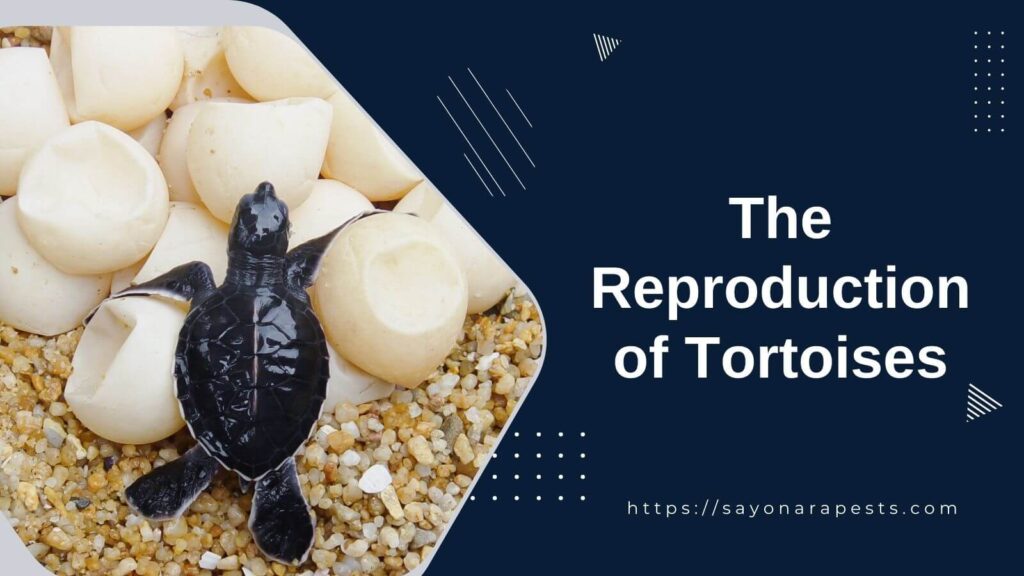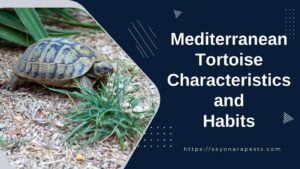The mysterious world of tortoises is made up of many different kinds of reptiles that have long been interesting to both scientists and nature lovers.
Tortoises have become enduring symbols of patience and longevity because of their strong shells and slow pace. But behind the way they look is a complicated, mysterious, and fascinating world of reproduction.
Understanding the details of how tortoises reproduce is very important because it helps us figure out how their populations change, how they adapt, and how we can protect them.
By looking into how tortoises have babies, scientists can not only learn more about the amazing ways these ancient animals reproduce, but they can also find ways to protect them and keep them alive in the future.
Get ready for a fascinating trip through the mysterious world of tortoise reproduction, where untold stories of survival and reproduction are waiting to be found.
Mating Behaviors of Tortoises
The Mating Season And Courtship Rituals
The complicated world of tortoise mating reveals a fascinating range of rituals, strategies, and adaptations that have developed over millions of years. Tortoises start their courtship rituals during the mating season, which is a very important time in their lives.
During this time, male tortoises do a lot to attract females, like shaking their shells and bobbing their heads. They also make unique sounds.
These courtship rituals serve as a way to talk to each other and find a mate. They also help people find good matches within their own species.
Unique Mating Behaviors Of Different Tortoise Species
Remarkably, different species of tortoise have developed very different ways of mating that reflect their ecological niche and how they have changed over time.
For example, Galapagos giant tortoises have huge mating rituals in which the males use their size and strength to show that they are the strongest.
Hermann’s tortoises, on the other hand, have complicated courtship rituals that look like dances and include head movements, circling, and gentle biting.
These species-specific behaviors not only help animals find mates but also show how healthy and compatible they are.
Male Aggression And Territorial Behavior During Mating Season
But the mating season isn’t always easy, especially for the male tortoises. During this time, males get more aggressive and territorial as they try to get close to females.
When two men fight, they can do anything from gentle ramming and shell biting to full-on wrestling.
These kinds of competitions set the social order, with the most powerful males getting to mate first. These fights show how important physical traits and stamina are to the ability of male tortoises to reproduce.
Reproductive Cycles
Tortoises have different reproductive cycles based on their species and where they live. Some tortoises mate once a year, while others may do it every two years or even longer.
Climate, the availability of resources, and ecological pressures all affect when and how long the mating season lasts.
Understanding these cycles gives us important information about how tortoise populations change over time and how well they can adapt to environments that are always changing.
Sexual Dimorphism Among Tortoises
Sexual dimorphism, which is when the bodies of male and female members of the same species look different, is common in tortoises. Males are often easy to tell apart because they are bigger, have longer tails, or have ornaments like spurs or colors that stand out more.
These features that are different for males and females often help males choose mates and compete with each other during courtship.
By looking at these differences in shape, researchers can learn more about how tortoise reproduction strategies have been shaped by the forces of evolution.
Reproductive Success Rates
Tortoise species have different reproductive success rates, which are measured by the number of babies born per breeding attempt. Reproduction is affected by age, size, health, and the quality of the mate.
Also, environmental factors like temperature and the way it rains can have a big effect on how well eggs hatch. Studying these success rates is important for figuring out how well tortoise populations can reproduce and for coming up with good ways to protect them.
Female Mate Selection And Breeding Strategies
Tortoise populations’ genetic diversity and ability to survive depend a lot on how they choose female mates and how they raise their young.
When choosing a mate, female tortoises are often picky, choosing males with desirable traits or better genetic quality.
Polyandry is a strategy in which females mate with more than one male. This increases genetic diversity and helps the survival of offspring.
Researchers can figure out how genetic variation, reproductive success, and population dynamics all work together by studying how females choose their mates and how they breed.
Copulation And Fertilization
Tortoises mate and have babies after going through courtship rituals and choosing a partner. Usually, the male mounts the female puts himself on her carapace or back legs, and copulates with her for a variable amount of time.
The process lets the sperm move from the male to the female so that the eggs can be fertilized. Tortoises have internal fertilization, and the female stores sperm for a long time before ovulation and egg laying.
This change makes sure that fertilization happens at the best time, which makes it more likely that the animal will be able to reproduce.
Tortoises have a complex set of mating habits, reproductive cycles, sexual differences, and breeding strategies that show how adaptable and different these ancient animals are.
Exploring these aspects not only helps us learn more about how tortoises live but also has important implications for protecting them.
By figuring out how tortoises have babies, scientists will be able to protect these interesting reptiles so that they will be around for future generations to admire.
Egg-Laying Process of Tortoises
Nest Site Selection And Preparation
Tortoises lay their eggs in a very well-planned way that is affected by many things that are important for the development and survival of their young.
Choosing and preparing a safe place to lay eggs is very important for making sure that the eggs hatch in the best way possible.
Female tortoises carefully check out their surroundings, looking for places that are safe from predators, have the right temperature, and have the right amount of water.
Once a good spot is found, the process of building a nest starts.
Nest Construction
The female tortoise works hard to dig a hole in the ground for her nest. She does this by using her strong back legs.
The size and depth of the nest vary from species to species and can be affected by the soil, the amount of vegetation, and the weather. The female carefully puts her eggs in the nest.
She usually does this in layers, with loose soil or plants between each layer. This helps to keep the eggs warm and keep the microclimate stable while they are incubating.
Nest Predation
Tortoise eggs are in danger when their nests are attacked by animals. Many animals that eat eggs, like mammals, birds, and reptiles, are drawn to them by their smell and because they are easy prey.
To keep this from happening, female tortoises hide their nests in different ways. They may hide at the entrance to the nest or choose places with lots of plants to keep predators away.
But even with all of these efforts, predators are still a problem, and the survival of tortoise eggs depends on a delicate balance between hiding the nest and staying away from predators.
The Importance Of Temperature In Egg Development
Effect Of Incubation Temperature On The Development Of Tortoise Embryos
The temperature is a very important part of how tortoise embryos grow and develop. The temperature of the egg’s incubator has a big impact on how fast the embryo grows and develops, as well as on the hatchlings’ overall health and ability to live.
In many species of tortoise, the temperature at which the eggs are incubated during key stages of development determines whether the offspring will be male or female.
This is called “temperature-dependent sex determination,” and it shows how sensitive tortoise reproduction is to the environment.
Egg-Laying And Incubation Periods
Tortoise species can have very different times for laying eggs and letting them hatch. Some tortoises, like those that live in the desert, have shorter incubation periods because their environments are warmer.
On the other hand, tortoises that live in cooler places or at higher altitudes may have longer periods of incubation.
The different times for incubation are adaptations that make sure the hatchlings come out when the environment is best for their survival.
Hatching And Juvenile Care
Hatching Behaviors Of Tortoises
Tortoises use a wide range of instinctual actions and adaptations to help their eggs hatch. As the embryos get close to being ready to hatch, they crack the eggshell open with a special structure on their snout called an “egg tooth.”
This can take a few hours or even a few days, and the babies come out of the eggs tired but determined.
Once they hatch, baby tortoises do a lot of different things, like leave the nest, look for shelter, and hunt for food.
Some species may not take very good care of their young, giving them little protection or guidance.
Juvenile Tortoise Survival Rates
The survival rates of young tortoises are affected by many things, such as predators, the quality of their habitat, and the availability of food and water. Teenagers have to deal with a lot of problems in their environment, which requires them to be strong and flexible.
Hatchlings are at risk from predators like birds, mammals, and even other reptiles, and death rates can be high in the early stages of life.
But tortoise populations have come up with ways to make up for these losses. For example, some species lay more eggs to increase their chances of survival.
Tortoises lay eggs in a way that is an intricate coordination between the environment, the way they reproduce, and natural selection.
Tortoise populations are shaped by how they choose where to build their nests, how their sexes are determined based on the temperature, how long they stay in the egg, how they act when they hatch, and how many of their young survive.
Understanding these complicated processes gives researchers important information about the problems these ancient reptiles face. It also helps them come up with effective ways to protect these amazing creatures and make sure they will be around for generations to come.
Factors Affecting Tortoise Reproduction
Effect Of Climate Change On Tortoise Reproduction
The way tortoises reproduce is complicated by many environmental, ecological, and human factors, all of which can have a big effect on their ability to reproduce and on the way their population changes over time.
Climate change is one of the most important problems tortoises have had to deal with in recent years. Tortoise populations around the world are in danger because of things like rising temperatures, changing patterns of rainfall, and extreme weather events.
Changes in climate can throw off the delicate balance of how sex is determined by temperature, which could lead to skewed sex ratios and less genetic diversity.
Also, changes in the way it rains can affect the availability of places to nest and the way plants grow, which can affect how tortoises reproduce and how well their habitat suits them.
Environmental Factors Such As Temperature, Humidity, And Light
Tortoises reproduce based on many things in their environment, such as temperature, humidity, and light. The ideal incubation temperature range is important for the proper development of the embryo and for figuring out the sex of the hatchling.
Changes in the temperature of the environment can throw off this delicate balance, which can lead to more skewed sex ratios and make it harder for tortoises to have babies.
Changes in humidity and light patterns can also affect where birds choose to nest, how warm or cool their nests are, and how many babies they have. These things show how easily tortoises can be hurt by even small changes in their environment.
Habitat Loss And Fragmentation
Tortoise populations all over the world are in danger because of habitat loss and fragmentation. Tortoise habitats have been destroyed and made worse by things that people do, like building cities, farming, and building roads and bridges.
If tortoises lose good places to nest, their migration routes get messed up, or they can’t get enough food and water, it can have a big effect on how they reproduce and how well their populations are connected.
When habitats are broken up, the risk of inbreeding goes up and genetic diversity goes down. This makes it harder for tortoise populations to survive and adapt in the long run.
Human Disturbance And Exploitation
Human disturbance and exploitation have dire consequences for tortoise reproduction. Tortoise populations can be wiped out by direct disturbances like habitat loss, poaching, and taking tortoises for the pet trade.
Taking individuals out of the wild changes the way they breed, reduces genetic diversity, and hurts the species’ overall ability to reproduce.
Also, human activities that disturb nesting sites, like recreation, off-road vehicle use, and development along the coast, can reduce the success of nesting and make birds more vulnerable to being eaten.
Predation And Disease
Predators and diseases make it hard for tortoises to have babies. Mammals, birds, and reptiles, which are all-natural predators, can eat both eggs and hatchlings, leading to high death rates. The problem is made worse when invasive predators are brought into tortoise habitats.
These animals often don’t have natural predators, so they can quickly wipe out local tortoise populations. Also, diseases like respiratory infections and viral outbreaks can hurt a tortoise’s ability to reproduce, lower its fertility rate, and make it more likely to die.
Tortoises are easy targets for predators and diseases, which shows how important it is to keep ecosystems healthy and take steps to stop the spread of invasive species and diseases.
Impacts Of Invasive Species On Tortoise Reproduction
The spread of invasive species has become a major threat to tortoise reproduction. When non-native plants, animals, and pathogens are brought into an ecosystem, they can upset it and have a direct effect on tortoises.
Invasive plants can outcompete native plants and change the amount of food and places to nest that are available. Invasive predators can eat tortoises or their eggs, which makes it hard for them to have babies.
Also, invasive diseases and parasites can hurt the health and reproduction of tortoises. For tortoise populations to keep being able to reproduce, invasive species must be managed and kept under control.
Reproductive Health Of Tortoises
Tortoises need to be able to reproduce well in order to live for a long time. Reproductive fitness and success rates can be affected by things like age, nutrition, disease rates, and pollution.
Tortoises that are sick or weak because of things in their environment are less likely to have healthy babies.
Researchers can find potential threats to reproductive health and use conservation strategies to lessen their effects if they know what factors affect them.
Genetic Diversity of Tortoises
Genetic diversity is a key part of tortoise populations’ ability to stay alive and change over time. Less genetic diversity can make people less fertile, more likely to get sick, and less physically fit overall.
Tortoise populations can lose genetic diversity in a number of ways. These include fragmentation of habitats, small population sizes, and inbreeding caused by human disturbances.
Tortoises need habitat restoration, population translocations, and breeding programs in captivity, among other things, to keep their genetic diversity and make sure they can reproduce and stay alive.
Climate change, environmental factors, habitat loss, human interference, predation, invasive species, reproductive health, and genetic diversity all affect how tortoises have babies.
Recognizing and dealing with these many problems is important for making effective conservation plans that protect the future of these amazing reptiles and their important role in ecosystems around the world.
Conservation And Management Of Tortoise Populations
Importance Of Conservation Efforts For Tortoises
Tortoise populations need to be protected because they are important to the environment, have intrinsic value, and help keep biodiversity.
Conservation efforts are very important for protecting these amazing creatures’ habitats, their ability to have children, and their ability to live for a long time.
Tortoises are especially at risk of population decline and extinction because they grow slowly and are sensitive to changes in their environment. So, they need coordinated conservation efforts to help them deal with the many problems they face.
Captive Breeding And Reintroduction Programs
Tortoise populations have been helped a lot by programs to breed them in captivity and release them back into the wild.
In these programs, breeding centers or sanctuaries are set up where tortoises are kept in controlled conditions and bred to increase the number of tortoises in the wild.
When the animals raised in captivity are old enough and big enough, they are put back into their natural environments. The goals of these projects are to bring back declining populations, increase genetic diversity, and protect wildlife from threats.
Several endangered tortoise species have made a comeback thanks to captive breeding and reintroduction programs, which gives us hope for their long-term survival.
Role Of Local Communities In The Conservation Of Tortoises
For tortoises to be saved, it is very important for local communities to be involved. Local people often live in the same places as tortoises and have valuable traditional knowledge and insights about how they act, how they live, and what they mean to them culturally.
Getting people involved in conservation efforts gives them a sense of ownership and responsibility, which is important for the long-term care of tortoise populations.
Community-based conservation efforts might include campaigns to raise awareness, training programs, ways to make a living, and the creation of protected areas with the help and participation of local people.
Policies And Legislation In Protecting Tortoises
Policies and laws are very important for protecting tortoises and the places they live. Governments and conservation groups all over the world have passed laws and rules to protect animals from threats like habitat loss, illegal trade, and poaching.
The goal of these policies is to make wildlife crimes more serious, control the trade in tortoises and their parts, and set up protected areas and reserves.
Effective policies and laws must be made and put into place to protect tortoises and their habitats.
Habitat Restoration And Protection
The most important parts of tortoise conservation are restoring and protecting their habitats. To fix up damaged habitats, people do things like plant trees, connect habitats, and get rid of invasive species.
Setting up nature reserves, national parks, and wildlife corridors to protect important habitats makes sure that tortoises have places to live where they can thrive.
The long-term survival of tortoise populations is also helped by actions to protect their habitats, such as regulating how land is used, reducing pollution, and managing human activities.
Education And Awareness Campaigns
Education and awareness campaigns are one of the most important ways to get people to care about and understand tortoises.
The goal of these campaigns is to make more people aware of how important tortoises are for the environment, how well they are protected, and what dangers they face.
Education and awareness campaigns can help stop illegal trade and habitat destruction by encouraging people to do the right thing, like not buying tortoises caught in the wild as pets and not destroying their natural habitats.
Also, education programs for schools, local communities, and tourists help teach people how to take care of the environment and encourage future generations to get involved in tortoise conservation.
Tortoise conservation and management require a multifaceted approach that brings together scientific research, community involvement, policy development, habitat restoration, education, and more.
By addressing the tortoises’ complicated problems and putting in place effective conservation strategies, we can make sure that these amazing animals and the important things they do for the ecological balance of our planet will be around for a long time to come.
In the end, understanding how tortoises reproduce is the most important thing for protecting and managing them.
The fact that different species of tortoises have different mating habits, that they have different reproductive cycles, and that they look different depending on their gender shows how adaptable and diverse they are.
By figuring out these complicated things, researchers can come up with targeted conservation plans that will help tortoise populations stay alive in the long run.
But it’s important to recognize that there are still a lot of things we don’t know about how tortoises have babies.
Even though a lot has been learned, there is still a lot to learn about how they mate, how the environment affects their ability to have children, and how different populations’ genes are.
Readers who want to learn more about these topics are encouraged to look at outside resources and websites that have more information about how tortoises have babies.
These sources can give you useful information and help you get a better understanding of how tortoises reproduce.
Now that people know more about tortoises, it is important that they take action and get involved in saving them.
Each person can make a difference by giving money to local and international conservation groups, taking part in citizen science projects, and spreading the word about how important it is to protect tortoise habitats.
By working together, we can make sure that these ancient reptiles will still be around for future generations to be amazed by.
As time goes on, the future of tortoise populations depends on how much we all work to protect them.
Tortoise populations and their habitats need to be protected in a number of ways, including habitat restoration and protection, captive breeding and reintroduction programs, community involvement, policy development, and education programs.
We can help tortoises have a better future by tackling problems like climate change, habitat loss, human disturbance, predators, and diseases.
Because there are always new risks and unknowns, it is very important that we keep an eye out for tortoises and work hard to protect them. These amazing creatures have survived for millions of years, and it is our job to make sure they will continue to do so for many more.
By valuing and protecting these ancient reptiles, we not only keep a part of our natural history alive, but we also help keep our planet’s ecosystems healthy and diverse. Let’s work together to make sure that tortoises will still be around in the future.











